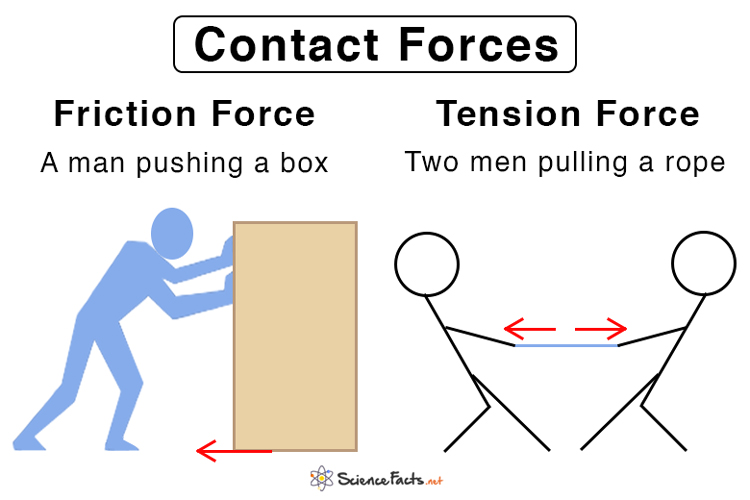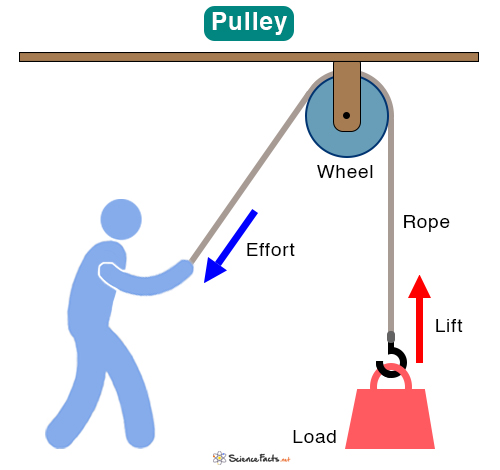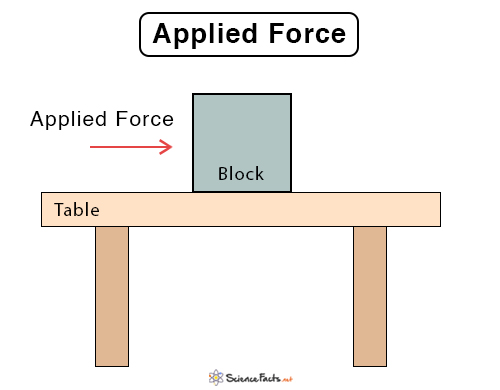Shear Stress
In physics and mechanics, stress is defined as the force applied to a material divided by the area over which the force is distributed. Shear stress occurs when this force acts along the surface of an object rather than pressing directly into it.
A simple way to visualize shear stress is to consider a block resting on a table, as shown in the image below. If the block is pushed on the side while the bottom stays in place due to friction, it will start to deform slightly. The applied force, also known as shear force, is parallel to the top and bottom surfaces of the block, creating shear stress within the material. If the force is strong enough, the block may deform or even break.
Shear Stress Formula
Shear stress, denoted by the Greek symbol τ (tau), is calculated using the formula:
τ = F/A
Where:
– F: Applied shear force
– A: Cross-sectional area over which the force is distributed
This formula tells us that shear stress depends on both the applied force and the area it acts upon. If the force increases, the shear stress increases. However, if the area is larger, the shear stress decreases because the force is spread out over a bigger surface.
Units
The unit of force is Newton (N), and the unit of area is square meters (m2). Since shear stress is force divided by area, its unit is Newton per square meter (N/m2) or Pascal (Pa). Since shear stress values are high for some materials, they are often expressed in megaPascals (MPa).
1 MPa = 106 Pascals
Material Response to Shear Stress
Different materials respond to shear stress in different ways based on their properties:
- Metals – Due to their strong atomic bonds, metals can withstand high shear stress, making them ideal for structural applications.
- Rubber and Polymers – They are flexible and can stretch or bend under shear stress without breaking, making them useful in tires, seals, and shock absorbers.
- Brittle Materials (Glass and Ceramics) – They cannot handle much shear stress and tend to crack or shatter when exposed to it.
Engineers select materials based on shear strength, which is the maximum shear stress a material can withstand before failing. It helps them design structures and mechanical parts that remain strong and safe under shear stress.
Materials deform due to shear stress. Let us understand this deformation.
Shear Strain
The deformation of an object due to shear stress is termed shear strain. It measures how much an object distorts or twists due to shear force.
For example, imagine a rubber eraser placed on a table. If you push on one side while keeping the bottom side fixed, the eraser tilts into a parallelogram shape. The more you push, the more it deforms. Shear strain represents angular deformation, often without significant volume change.
Shear Strain Formula
Shear strain, denoted by the Greek symbol γ (gamma), is defined by the formula:
γ = Δx/h
Where:
– Δx: Displacement due to shear stress
– h: Length of the material perpendicular to the displacement
If the displacement is horizontal, h represents the height of the material. The equation shows that if the displacement increases or the height decreases, the shear strain becomes larger.
Units
Shear strain is unitless since it is a ratio of two lengths (both in meters).
Relation Between Shear Stress and Shear Strain
The relationship between shear stress (τ) and shear strain (γ) is defined by Hooke’s Law, which states that, within the elastic limit, stress is proportional to strain.
τ = G·γ
Where G is the shear modulus, a material property that measures resistance to shear deformation.
G is different for different materials. A high shear modulus means the material resists deformation (e.g., metals), while a low shear modulus means the material deforms easily (e.g., rubber).
Normal Stress vs. Shear Stress
Normal stress is another type of stress widely studied in mechanics. Here is a comparison table between normal stress and shear stress:
| Feature | Normal Stress | Shear Stress |
|---|---|---|
| Definition | Stress acting perpendicular to a surface | Stress acting parallel to a surface |
| Force Direction | Acts perpendicular (normal) to the surface | Acts parallel (tangential) to the surface |
| Formula | σ = F/A (Force per unit area normal to the surface) | τ = F/A (Force per unit area tangential to the surface) |
| Types | Tensile stress and compressive stress | Transverse shear stress and torsional shear stress |
| Effect on Material | Causes elongation (tensile stress) or compression (compressive stress) | Causes sliding (transverse shear stress) or twisting (torsional shear stress) |
| Examples | Stretching a rubber band, compressing a rod | Pushing a deck of cards, twisting a can |
Example Problems with Solutions
Problem 1: A metal plate is subjected to a shear force of 100 N over an area of 0.5 m2. Calculate the shear stress acting on the plate.
Solution
We use the shear stress formula.
τ = F/A
Given:
– F = 100 N (shear force)
– A = 0.5 m2 (surface area)
Substituting these values:
τ = 100 N/0.5 m2 = 200 N/m2 or 200 Pa
The shear stress on the plate is 200 Pa.
Problem 2: A rubber block of height 0.2 m is fixed at the bottom and experiences a horizontal displacement of 0.01 m at the top due to shear stress. Calculate the shear strain in the block.
Solution
We use the shear strain formula.
γ = Δx/h
Given:
– Δx = 0.01 m
– h = 0.2 m
Substituting the values:
γ = 0.01 m/0.2 m = 0.05
The shear strain in the block is 0.05.
-
References
Article was last reviewed on Tuesday, June 10, 2025








